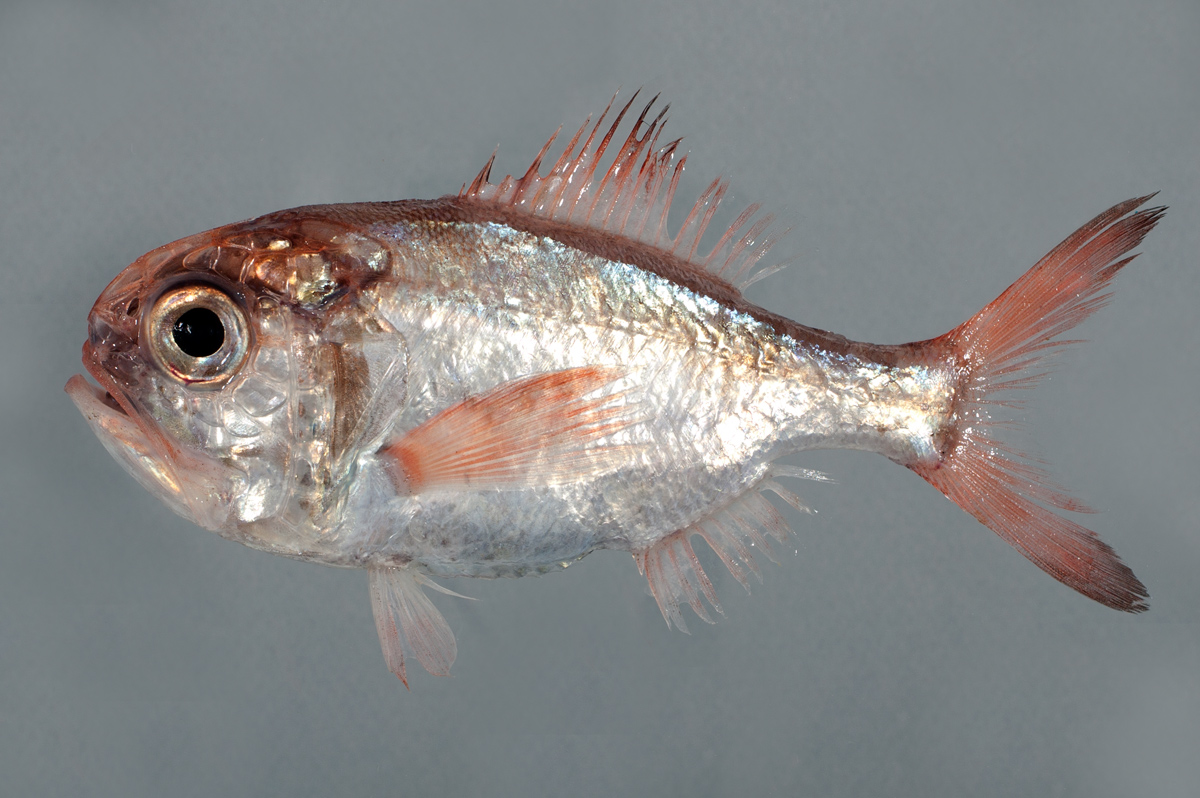- Classification
- ACTINOPTERYGII
- BERYCIFORMES
- TRACHICHTHYIDAE
- Hoplostethus
- mediterraneus
Blacktip Sawbelly, Hoplostethus mediterraneus (Cuvier 1829)
Other Names: Common Sawbelly, Mediterranean Slimehead, New Zealand Sawbelly, New Zealand Saw-belly, Sawbelly, Silver Roughy

Blacktip Sawbelly, Hoplostethus mediterraneus. Source: . License:
Summary:
A silvery sawbelly with a rosy hue, fins transparent to reddish with black margins on the caudal-fin tips and the soft dorsal fin, the inside of the mouth black and the floor of the mouth pale only in front of the first gill arch.
In Australia, this species has previously been referred to as Hoplostethus intermedius (a junior synonym).
In Australia, this species has previously been referred to as Hoplostethus intermedius (a junior synonym).
Cite this page as:
Bray, D.J. 2020, Hoplostethus mediterraneus in Fishes of Australia, accessed 19 Apr 2024, https://fishesofaustralia.net.au/home/species/3732
Blacktip Sawbelly, Hoplostethus mediterraneus (Cuvier 1829)
More Info
|
Distribution |
Off Wooli, New South Wales, to south of Cape Leeuwin, Western Australia (absent from Bass Strait); also on the Lord Howe Rise and Norfolk Ridge in the Tasman Sea. Elsewhere the species occurs in the Atlantic (Mediterranean Sea), the western and southeastern Indian Ocean, and the southwestern Pacific. Aggregates around seamounts on the continental slope, most commonly at depths of 200-600 m. |
|
Features |
Dorsal fin VI, 12-14; Anal fin III, 9-11; Caudal fin 19; Pectoral fin 14-16; Pelvic fin I, 6; Lateral line scales 26-30; Abdominal scutes 9-10; Gill rakers 7-8 + 15-16. Body moderately deep (44-49% SL), oval, compressed. Head large (37-43% SL); eyes large (34-41% HL); mouth large, angled obliquely, extending beyond eye; expanded posterior end of maxilla with three to five divergent spinulose ridges dorsally, one or two ventrally; teeth tiny, in broad band on each jaw; spine at corner of preopercle; bony ridges thin and delicate; mucous cavities deep, covered by thin skin. Scales of moderate size, thin, slightly ctenoid, weakly attached; lateral line nearly straight, scales enlarged; about nine or ten strong scutes on belly. Anus immediately preceding anal fin. Single dorsal fin with base of moderate length, spines smooth, weak, succeeding spines increasing in length, first few soft rays longer than longest spine, succeeding rays decreasing in length; anal fin with short base, located below rear of dorsal fin; margins of soft dorsal and anal fins nearly straight; caudal fin forked. Pelvic fins arising below pectoral fins. |
|
Size |
|
|
Feeding |
Feeds mostly on benthopelagic crustaceans (prawns), and occasionally on small fishes including myctophids. |
|
Fisheries |
May be taken as by-catch in deep commercial trawls. |
|
Species Citation |
Hoplostethus mediterraneus Cuvier, in Cuvier & Valenciennes 1829, Histoire Naturelle des Poissons Vol. 4 :469, pl. 97. Type locality: Nice, France, northwestern Mediterranean Sea. |
|
Author |
Bray, D.J. 2020 |
|
Resources |
Blacktip Sawbelly, Hoplostethus mediterraneus (Cuvier 1829)
References
Cuvier, G.L. in Cuvier, G.L. & Valenciennes, A. 1829. Histoire Naturelle des Poissons. Paris : Levrault Vol. 4 518 pp. pls 72-99. See ref at BHL
Gomon, M.F. 1994. Families Trachichthyidae, Monocentridae. pp. 399-412 figs 358-369 in Gomon, M.F., Glover, C.J.M. & Kuiter, R.H. (eds). The Fishes of Australia's South Coast. Adelaide : State Printer 992 pp. 810 figs. (as Hoplostethus intermedius)
Gomon, M.F. 2008. Family Trachichthyidae. pp. 420-430 in Gomon, M.F., Bray, D.J. & Kuiter, R.H. (eds). Fishes of Australia's Southern Coast. Sydney : Reed New Holland 928 pp. (as Hoplostethus intermedius)
Hector, J. 1875. Descriptions of five new species of fishes obtained in the New Zealand seas by H.M.S. Challenger Expedition July 1874. Annals and Magazine of Natural History 4 15(11): 78-82 (described as Trachichthys intermedius) See ref at BHL
Iwamoto, T., Moore, J., Polanco Fernandez, A., Russell, B. & McEachran, J.D. 2015. Hoplostethus mediterraneus . The IUCN Red List of Threatened Species 2015: e.T198579A20682773. https://dx.doi.org/10.2305/IUCN.UK.2015-4.RLTS.T198579A20682773.en. Downloaded on 12 January 2020.
Jones, M.R.L. 2009. Diets of eight fish species from the upper slope off the Wairarapa coast, North Island, New Zealand, with notes on the diets of others. New Zealand Journal of Marine and Freshwater Research 43(4): 929-939, https://doi.org/10.1080/00288330909510051
Kerstan, S.L. 1989. The food of silver roughy (Hoplostethus mediterraneus, Beryciformes, Trachichthyidae) from New Zealand waters. Meeresforschung 32(3): 241-247.
May, J.L. & Maxwell, J.G.H. 1986. Field Guide to Trawl Fish from Temperate Waters of Australia. Hobart : CSIRO Division of Marine Research 492 pp. (as Hoplostethus intermedius)
McCulloch, A.R. 1914. Report on some fishes obtained by the F.I.S. Endeavour on the coasts of Queensland, New South Wales, Victoria, Tasmania, South and South-Western Australia. Part 2. Biological Results of the Fishing Experiments carried on by the F.I.S. Endeavour 1909-1914 2(3): 77-165 figs 1-15 pls 13-34 See ref at BHL
Paulin, C.D. 1979. New Zealand roughies (Pisces: Berycomorphii: Trachichthyidae). New Zealand Journal of Zoology 6: 69-76 figs 1-5 https://doi.org/10.1080/03014223.1979.10428349, open access
Roberts, C.D. & Gomon, M.F. 2012. A review of giant roughies of the genus Hoplostethus (Beryciformes, Trachichthyidae), with descriptions of two new Australasian species. Memoirs of Museum Victoria 69: 341–354
Roberts, C.D. & Gomon, M.F. 2015. Family Trachichthyidae. pp.1009-1021 in Roberts, C.D., Stewart, A.L. & Struthers, C.D. The Fishes of New Zealand. Wellington : Te Papa Press Vol. 3 pp. 577-1152.
Scott, T.D., Glover, C.J.M. & Southcott, R.V. 1974. The Marine and Freshwater Fishes of South Australia. Adelaide : Government Printer 392 pp. figs. (as Hoplostethus intermedius)
Smith, P.J. & Roberts, C.D. 2004. Silver roughy: how many species? Seafood New Zealand 6(2): 62–63




